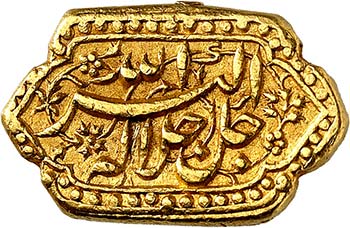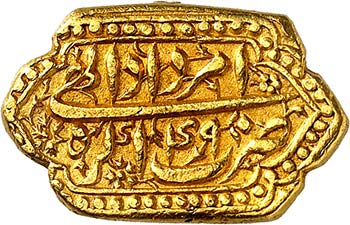- Home
- Auction 11 - A Royal Collection
- 23 An extraordinary rarity and a revolution in Islamic ...
Lot 23 - Auction 11 - A Royal Collection
Bids
Description
Jalal al-din Muhammad Akbar b. Humayun, AH 963-1014 (1556-1605 CE). AV Mihrabi Mohur, Month of Amardad, Ilahi year 49 (AH 1013), Agra. In the shape of a lozenge; Inscription "Allah uh Akbar" at the top and "Jal Jallah" at the bottom in a dotted border / Ilahi month at the top and Ilahi year and mint at the bottom. The background ornamented on both side. 10,89g. Lane Poole S., Coins of the Mughal Emperors, London, 1892 (BMC Mughal), 168; Krause Mishler, 6th Edition 2009 (KM), 114.3; Friedberg, Gold Coins of the World, 2017 (Fr.), 728; Liddle Andrew, Coinage of Akbar, 2005 (Liddle Akbar), Type G35.
Grading/Status: Extremely fine and extremely rare.
This coin features several of Akbar's innovations to the coinage. The first is its weight. Akbar introduced the Mohur as the standard weight for his gold coinage at around 11 grams. He then initiated his own dating system, the Din-i-Ilahi (literally Faith of God). This calendar incorporated elements of the different religious beliefs in his empire. The Ilahi calendar was solar, divided into twelve months, rather than the lunar Hijri calendar. Months bore the same names as those of the Persian kings, corresponding to the feasts of the Zoroastrians. The first Ilahi year was that of Akbar’s accession in AH 963. Akbar used the unusual elongated and scalloped lozenge shape of the mihrabi Mohur on only two occasions and both were struck at the Mughal capital of Agra. They were made in the shape of the mihrab, which is the niche in the wall of the mosque indicating the qibla, the direction in which Muslims must face when praying. The first, and better known type, dated AH 981AH (1573/4 CE), features the Kalima, the names of the Rashidun (the Four Orthodox Caliphs) and the date on the obverse, with Akbar’s name, titles, the invocations “khallada Allah mulkahu jalla jalala” (may God perpetuate his rule, may his glory shine forth), and the mint name with the epithet baldat (meaning city or town) on the reverse. This coin was not intended for circulation, but as a presentation issue. It was struck in the same year as the completion of the Agra Fort and could have been intended as a gift during the inaugural ceremony. The present coin is an example of the second, and much rarer type. The obverse bears the invocation “Allahu akbar jalla jalala” (God is the greatest, may His glory shine forth), obviously referring to Akbar’s name. Akbar made this invocation standard for all the coins he struck using the Ilahi era. On the reverse is the name of the mint, Akbar’s capital Agra, the Ilahi year of his reign and the Ilahi month. Like the first mihrabi Mohur, the extreme rarity of this type suggests that is was intended as a special issue to be presented to Akbar’s courtiers.
Please use the registration form to send us your participation request, or, if you are already registered and authorized, use the login box on the top.
For any information please contact auction@ngsa.ch
Auction 11 - A Royal Collection
Categories
Auction: Auction 11 - A Royal Collection
Timetable
Pre-bidding - End
17 11 2019 20:00 CET
Room auction - Start
18 11 2019 14:30 CET
Contacts
Rond-point de Plainpalais 1, Ginevra, Genève, Switzerland
 Respecting your privacy is our priority
Respecting your privacy is our priority
This site uses cookies to improve user experience and to collect information on the use of the site. You can read our cookie policy, accept all cookies and continue browsing by clicking on "Accept" or customize your choice by clicking on "Customize".
Cookie Policy
Cookies
To make this site work properly, we sometimes install small data files called "cookies " on your device. Most of the big sites do the same.
What are cookies?
A cookie is a small text file that websites save on your computer or mobile device while you visit them. Thanks to cookies, the site remembers your actions and preferences (for example login, language, font size and other display settings) so that you do not have to re-enter them when you return to the site or browse from one page to another.
How do we use cookies?
Third party cookies
Google Analytics
This site uses Google Analytics to collect information about the use of users of its website. Google Analytics generates statistical and other information through cookies, stored on users' computers. The information generated relating to our website is used to make reports on the use of websites. Googl
How to control and modify cookies?
You can modify or withdraw your consent at any time from the cookie declaration on our website.
Privacy Policy
Find out more about who we are, how you can contact us and how we process personal data in our privacy policy .
The necessary cookies help to make the website usable by enabling basic functions such as page navigation and access to protected areas of the site. The website cannot function properly without these cookies.
| Name | Supplier | Purpose | Expiry |
|---|---|---|---|
| cookieConsent | Bid Inside | Stores the user's cookie consent status for the current domain | 6 months |
| PHPSESSID | Bid Inside | Preserve the user's status in the different pages of the site. | When the browsing session ends |
| f_display | Bid Inside | The f_display cookies memorize the display mode chosen by the user in the pages where there are lists | When the browsing session ends |
| f_page | Bid Inside | The f_page cookies store the page viewed by the user in the pages where there are lists | When the browsing session ends |
| f_rec_page | Bid Inside | The f_rec_page cookies store the number of elements to be displayed per page chosen by the user in the pages in which there are lists | When the browsing session ends |
| f_order_by | Bid Inside | The f_order_by cookies store the sorting parameter selected by the user in the pages where there are lists | When the browsing session ends |
| f_order_dir | Bid Inside | The f_order_dir cookies store the ordering direction chosen by the user in the pages where there are lists | When the browsing session ends |
| watch_list_show_imgs | Bid Inside | The watch_list_show_imgs cookie stores the user's choice to show or hide lot images on the watch list page | When the browsing session ends |
| selected_voice | Bid Inside | The selected_voice cookie stores the voice selected by the user for the speech synthesis present in the live auction | 1 Month |
| include_autobids | Bid Inside | The include_autobids cookie stores the user's choice to show or hide their auto-bids on the 'Your bids' page | 6 months |
Analytical cookies help to understand how visitors interact with the website, collecting and transmitting statistical information to the Data Controller.
| Name | Supplier | Purpose | Expiry |
|---|---|---|---|
| _ga | Register a unique ID used to generate statistical data on how the visitor uses the website. | 2 years | |
| _gat_gtag | Used by Google Analytics to limit the frequency of requests | 1 day | |
| _gat | Used by Google Analytics to limit the frequency of requests | 1 day | |
| _gid | Register a unique ID used to generate statistical data on how the visitor uses the website. | 1 day | |
| __utma | Bid Inside | Used to distinguish users and sessions. The cookie is created when the javascript library executes and no existing __utma cookies exists. The cookie is updated every time data is sent to Google Analytics. | 2 years |
| __utmt | Bid Inside | Used to throttle request rate. | 10 minutes |
| __utmb | Bid Inside | Used to determine new sessions/visits. The cookie is created when the javascript library executes and no existing __utmb cookies exists. The cookie is updated every time data is sent to Google Analytics. | 30 minutes |
| __utmc | Bid Inside | Not used in ga.js. Set for interoperability with urchin.js. Historically, this cookie operated in conjunction with the __utmb cookie to determine whether the user was in a new session/visit. | When the browsing session ends |
| __utmz | Bid Inside | Stores the traffic source or campaign that explains how the user reached your site. The cookie is created when the javascript library executes and is updated every time data is sent to Google Analytics. | 6 months |
| __utmv | Bid Inside | Used to store visitor-level custom variable data. This cookie is created when a developer uses the _setCustomVar method with a visitor level custom variable. This cookie was also used for the deprecated _setVar method. The cookie is updated every time data is sent to Google Analytics. | 2 years |
Preference technical cookies allow a website to remember information that affects the way the site behaves or presents itself, such as your preferred language or the region you are in.
We do not use cookies of this type.Profiling cookies are used for marketing purposes, to monitor website visitors. The intent is to display relevant and engaging ads for the individual user.
We do not use cookies of this type.Unclassified cookies are cookies that are being classified, together with individual cookie providers.
We do not use cookies of this type.





 24
24